The Story Behind the Restoration of the Bells
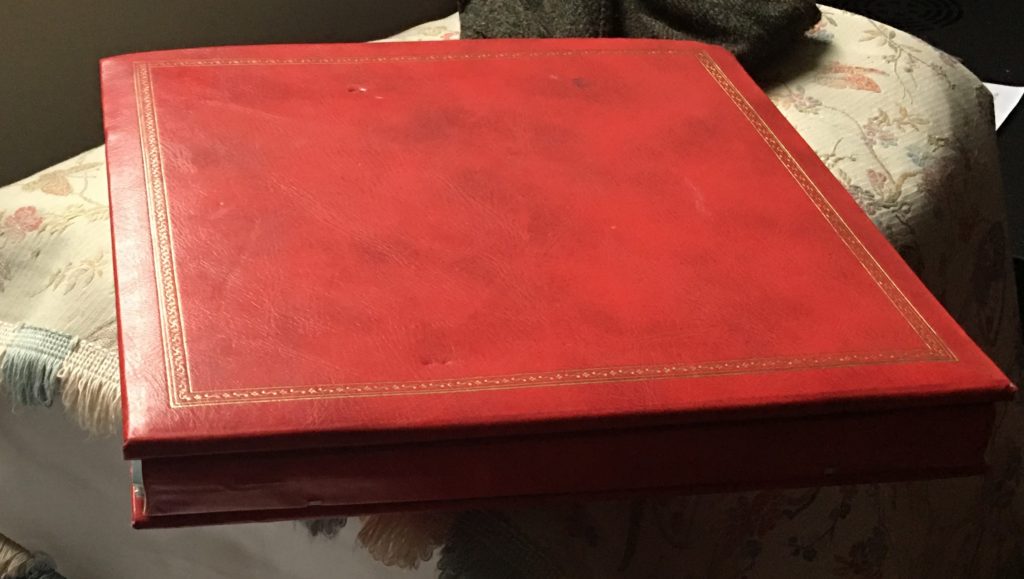
The above book contains details of the restoration of the bells in 1977/78. The book is kept in the vestry of the church.
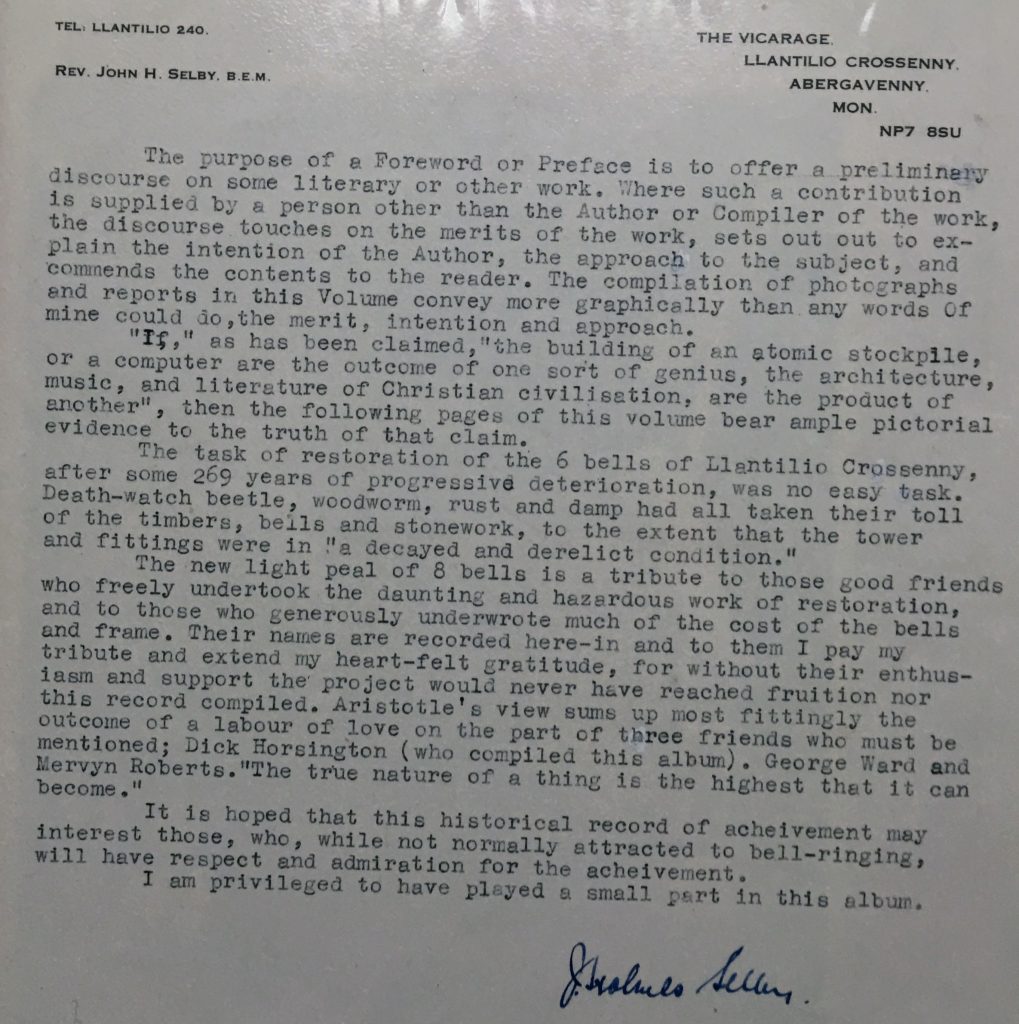
The above letter was written by Revd Selby as an introduction to the album.
The purpose of a Foreword or Preface is to offer a preliminary discourse on some literary or other work. Where such a contribution is supplied by a person other than the Author or Compiler of the work, the discourse touches on the merits of the work, sets out out to ex-plain the intention of the Author, the approach to the subject, and commends the contents to the reader. The compilation of photographs and reports in this Volume convey more graphically than any words of mine could do, the merit, intention and approach.
“If,” as has been claimed, “the building of an atomic stockpile, or a computer are the outcome of one sort of genius, the architecture, music, and literature of Christian civilisation, are the product of another”, then the following pages of this volume bear ample pictorial evidence to the truth of that claim.
The task of restoration of the 6 bells of Llantilio Crossenny, after some 269 years of progressive deterioration, was no easy task. Death-watch beetle, woodworm, rust and damp had all taken their toll of the timbers, bells and stonework, to the extent that the tower and fittings were in “a decayed and derelict condition.”
The new light peal of 8 bells is a tribute to those good friends who freely undertook the daunting and hazardous work of restoration, and to those who generously underwrote much of the cost of the bells and frame. Their names are recorded here-in and to them I pay my tribute and extend my heart-felt gratitude, for without their enthusiasm and support the project would never have reached fruition nor this record compiled. Aristotle’s view sums up most fittingly the outcome of a labour of love on the part of three friends who must be mentioned; Dick Horsington (who compiled this album). George Ward and Mervyn Roberts. “The true nature of a thing is the highest that it can become.”
It is hoped that this historical record of achievement may interest those, who, while not normally attracted to bell-ringing, will have respect and admiration for the achievement.
I am privileged to have played a small part in this album.
The story behind the removal of the old bells
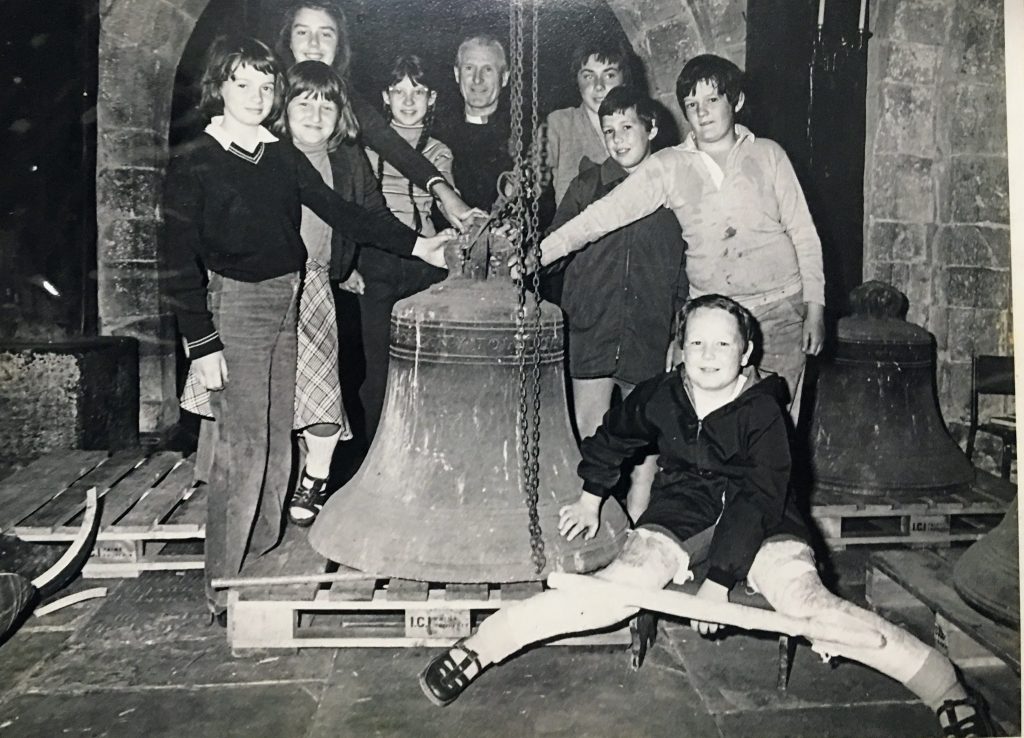
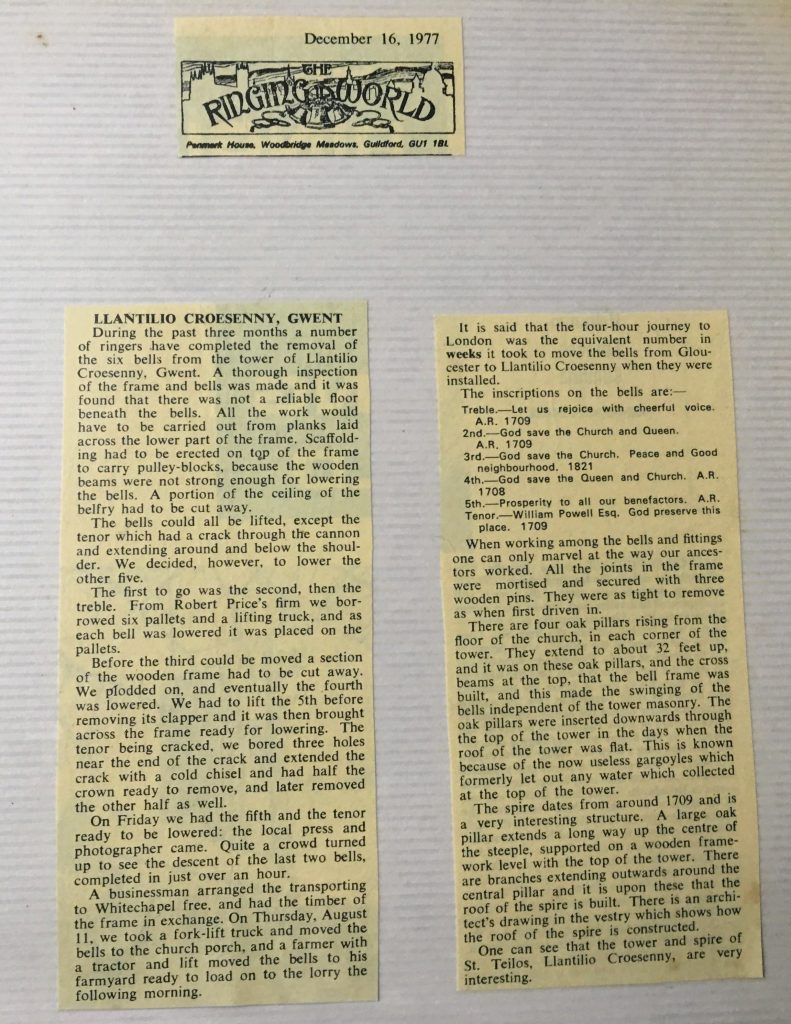
December 16, 1977
THE RINGING WORLD
Panment House, Woodbridge Meadows. Guildford, GU1 181
LLANTILIO CROESENNY, GWENT
During the past three months a number of ringers have completed the removal of the six bells from the tower of Llantilio Croesenny, Gwent. A thorough inspection of the frame and bells was made and it was found that there was not a reliable floor beneath the bells. All the work would have to be carried out from planks laid across the lower part of the frame. Scaffolding had to be erected on top of the frame to carry pulley-blocks, because the wooden beams were not strong enough for lowering the bells. A portion of the ceiling of the belfry had to be cut away.
The bells could all be lifted, except the tenor which had a crack through the cannon and extending around and below the shoulder. We decided, however, to lower the other five.
The first to go was the second, then the treble. From Robert Price’s firm we borrowed six pallets and a lifting truck, and as each bell was lowered it was placed on the pallets.
Before the third could be moved a section of the wooden frame had to be cut away. We plodded on, and eventually the fourth was lowered. We had to lift the 5th before removing its clapper and it was then brought across the frame ready for lowering. The tenor being cracked, we bored three holes near the end of the crack and extended the crack with a cold chisel and had half the crown ready to remove, and later removed the other half as well.
On Friday we had the fifth and the tenor ready to be lowered: the local press and photographer came. Quite a crowd turned up to see the descent of the last two bells, completed in just over an hour.
A businessman arranged the transporting to Whitechapel free, and had the timber of the frame in exchange. On Thursday, August 11, we took a fork-lift truck and moved the bells to the church porch, and a farmer with a tractor and lift moved the bells to his farmyard ready to load on to the lorry the following morning.
It is said that the four-hour journey to London was the equivalent number in weeks it took to move the bells from Gloucester to Llantilio Croesenny when they were installed.
The inscriptions on the bells are:
Treble Let us rejoice with cheerful voice. A.R. 1709
2nd-God save the Church and Queen. A.R. 1709
3rd-God save the Church. Peace and Good neighbourhood, 1821
4th. God save the Queen and Church A.R. 1708
5th Prosperity to all our benefactors. A.R. Tenor William Powell Esq. God preserve this place. 1709
When working among the bells and fittings one can only marvel at the way our ancestors worked. All the joints in the frame were mortised and secured with three wooden pins. They were as tight to remove as when first driven in.
There are four oak pillars rising from the floor of the church, in each corner of the tower. They extend to about 32 feet up, and it was on these oak pillars, and the cross beams at the top, that the bell frame was built, and this made the swinging of the bells independent of the tower masonry. The oak pillars were inserted downwards through the top of the tower in the days when the roof of the tower was flat. This is known because of the now useless gargoyles which formerly let out any water which collected at the top of the tower.
The spire dates from around 1709 and is a very interesting structure. A large onk pillar extends a long way up the centre of the steeple, supported on a wooden frame-work level with the top of the tower. There are branches extending outwards around the central pillar and it is upon these that the roof of the spire is built. There is an architect’s drawing in the vestry which shows how the roof of the spire is constructed. One can see that the tower and spire of St. Teilos, Llantilio Croesenny, are very interesting.
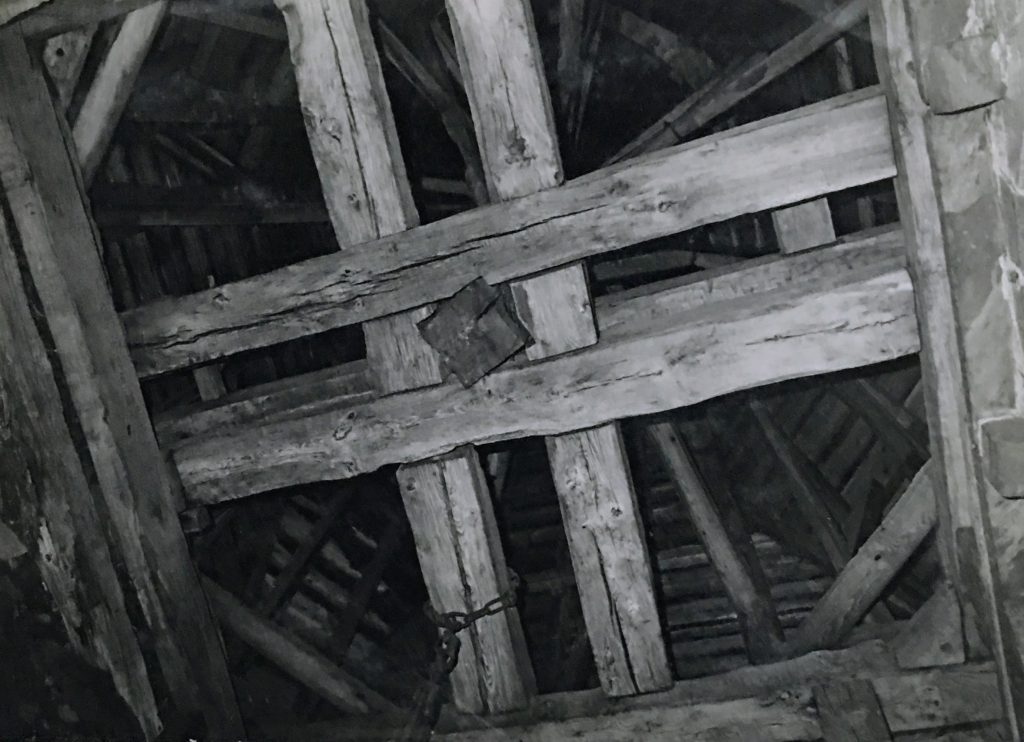
Upside-down view of the interior of the steeple. Chains were from the cross-beams to assist in the removing and installing of hung “the bells. The main cross timbers carry the butt of tree-trunk set up as the core on which the steeple was built of a 50 foot.
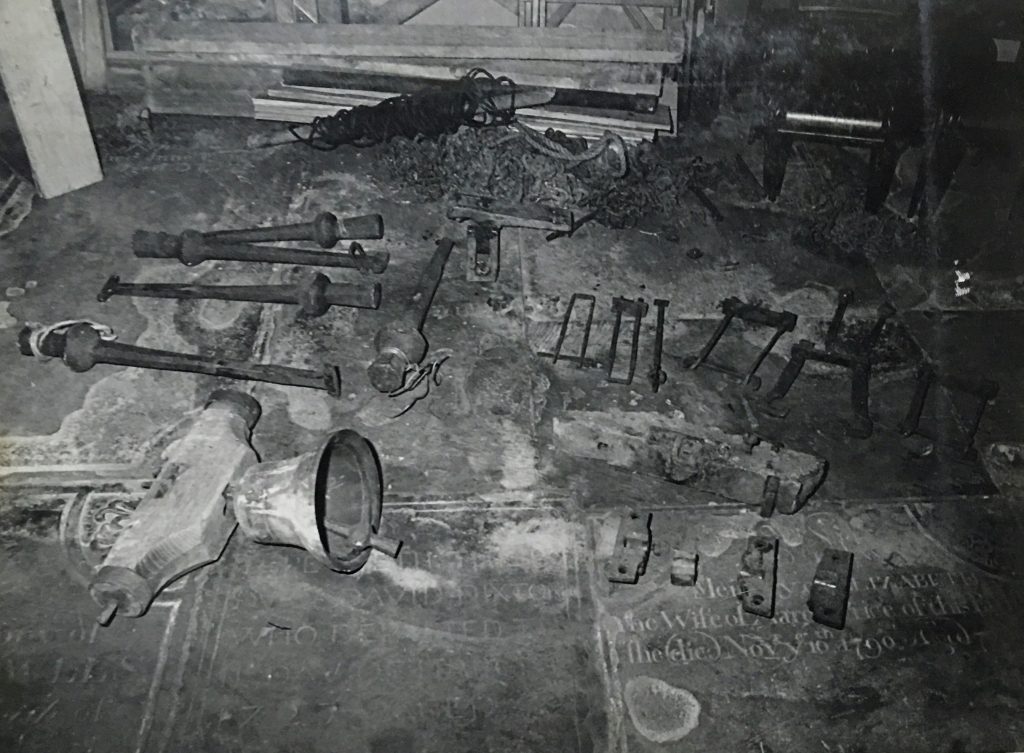
The image displays a collection of salvaged parts from removed bells, including a sanctus bell and various ironwork components, laid out on a church floor. The text beneath the image specifies that these are “Sanctus bell and spare iron works assembled on the church floor as salvaged parts of the removed bells”.
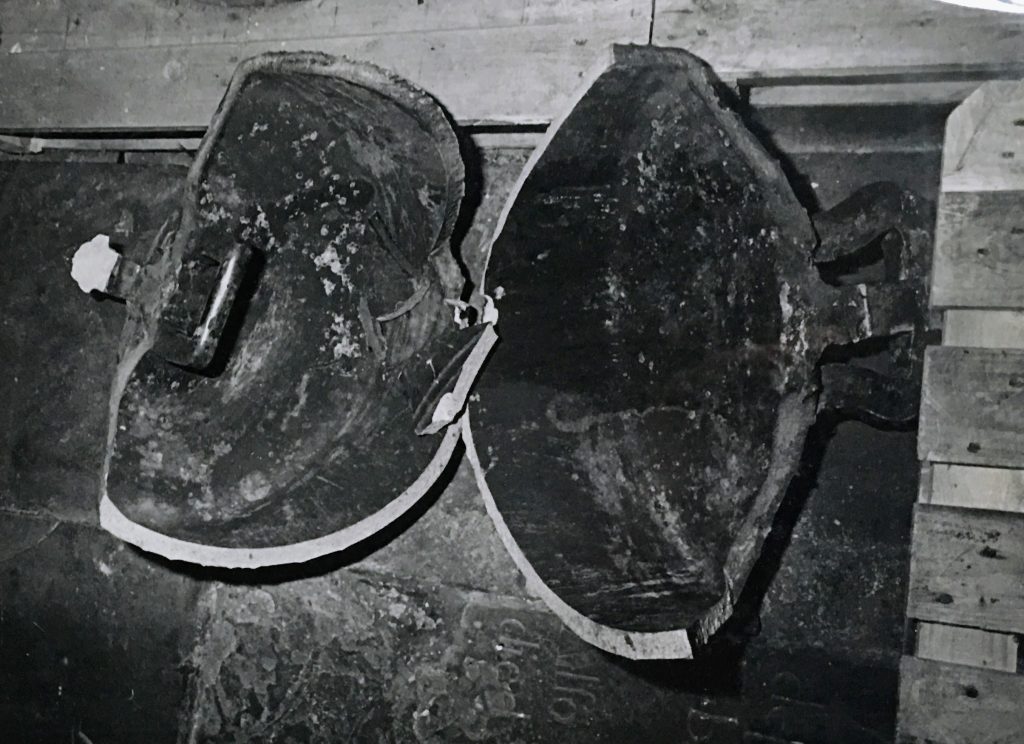
This image shows the crown and shoulders of a tenor bell that has undergone repair work, specifically highlighting a “dirty fracture” and a “clean cut” made on August 4th, 1977.
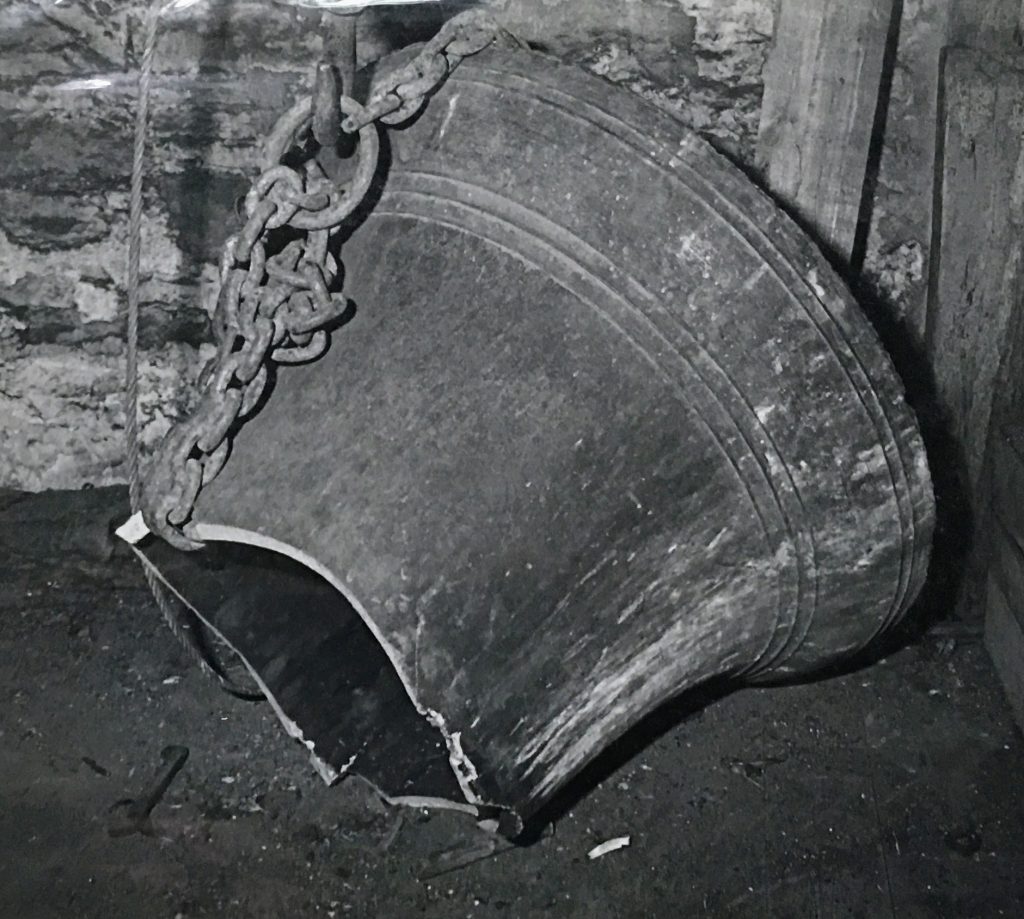
The photo was taken on Friday, August 4th, 1977.
It shows the greater part of a cracked tenor bell.
The bell is resting on the belfry floor.
It is described as being “on its way out,” likely indicating it was being removed or replaced.
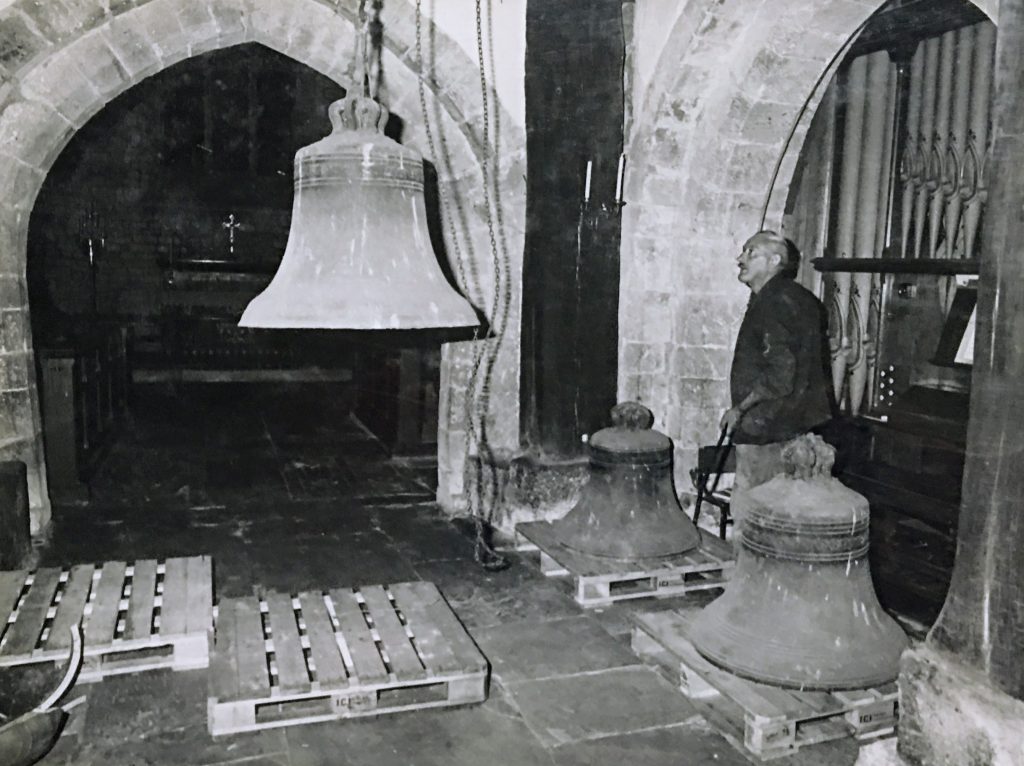
The image shows Mervyn Roberts in the organ arch of a church on August 4, 1977, as the last bell is being lowered from the tower.
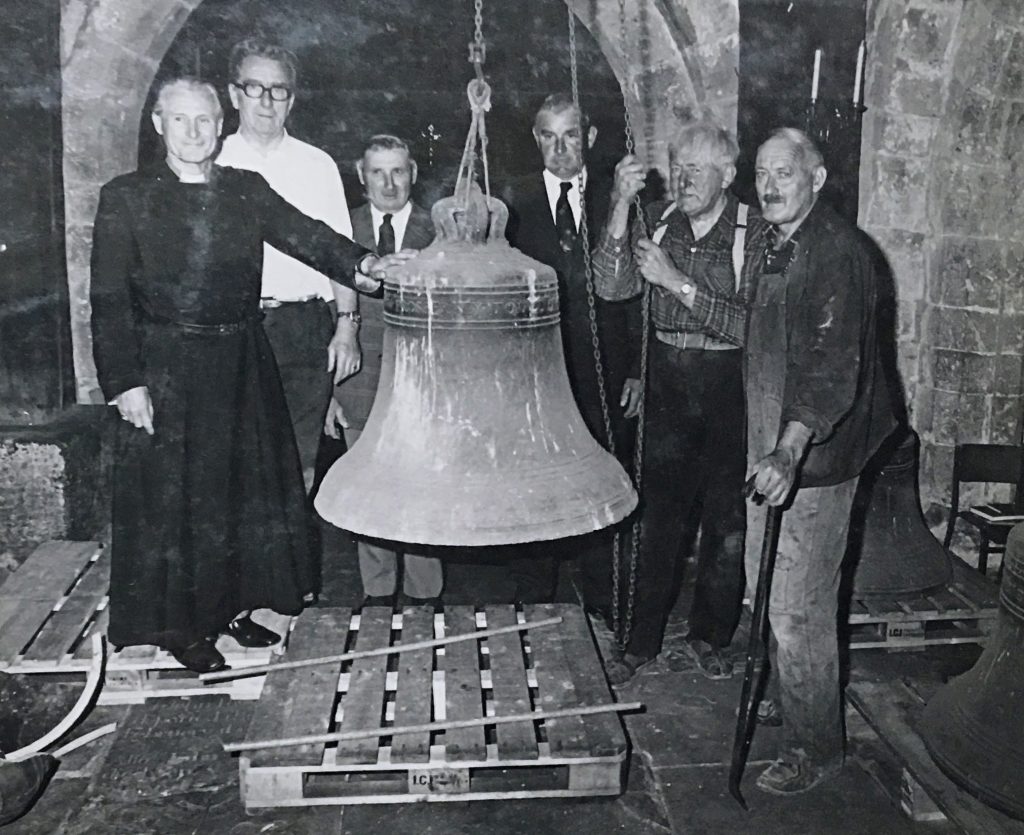
The image shows one of the bells being lowered before its transportation to Whitechapel. The photograph captures a moment in the bell’s history, likely related to maintenance or restoration work at a bell foundry.
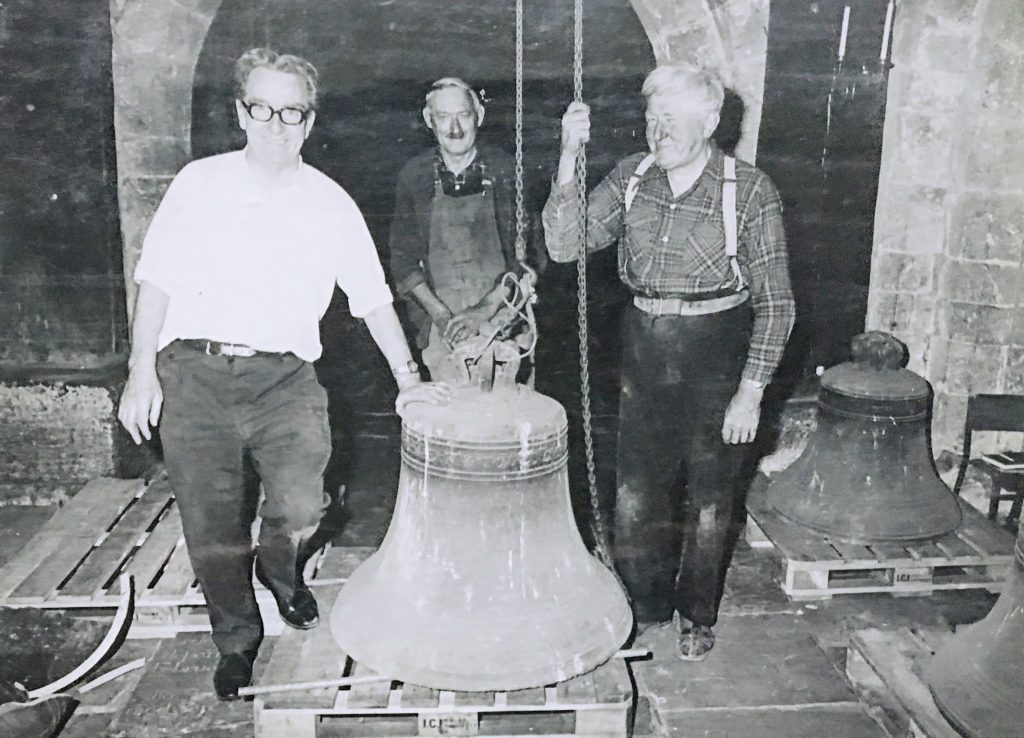
The image shows George Ward, Merryn Roberts, and Dick Horsington, who engineered work on church bells on August 4, 1977.
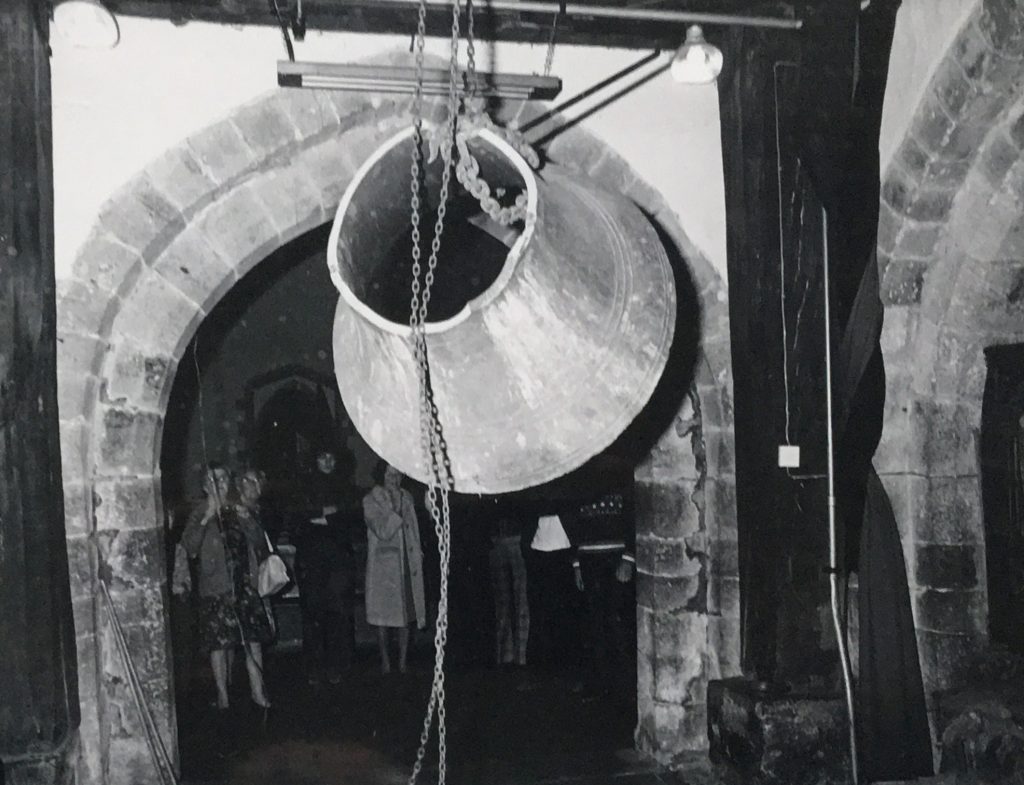
The image shows the tenor bell being lowered to the church floor. This is the moment as the last unit of bell metal was leaving the tower.
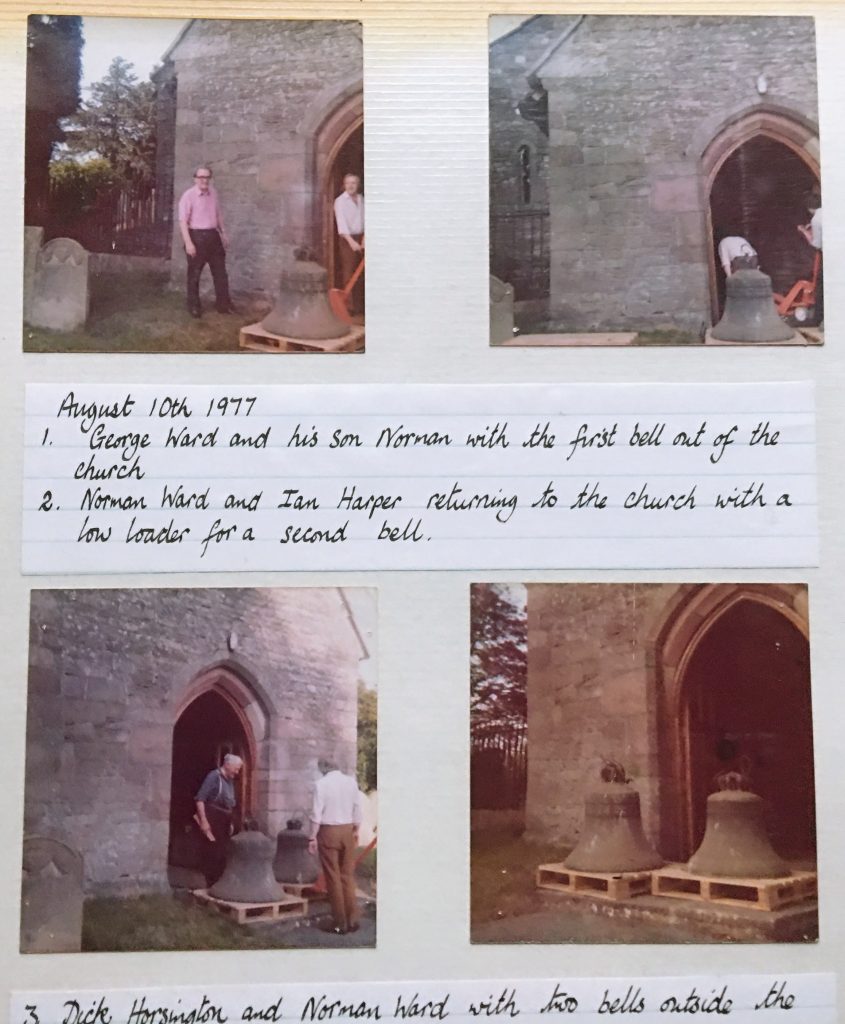
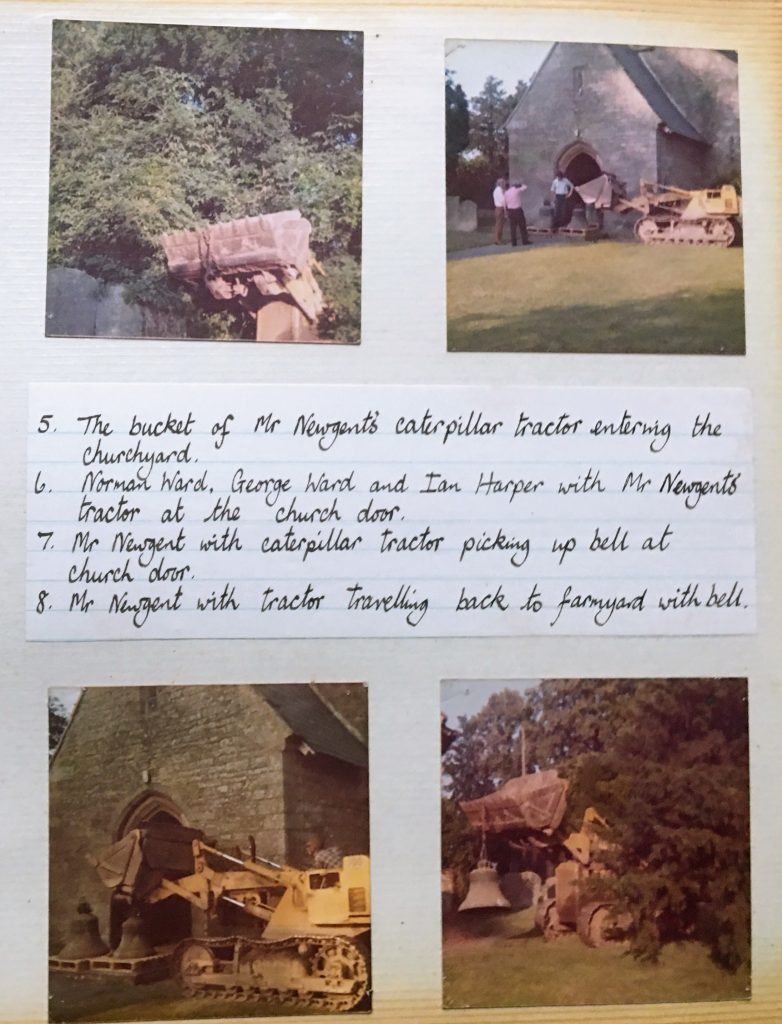
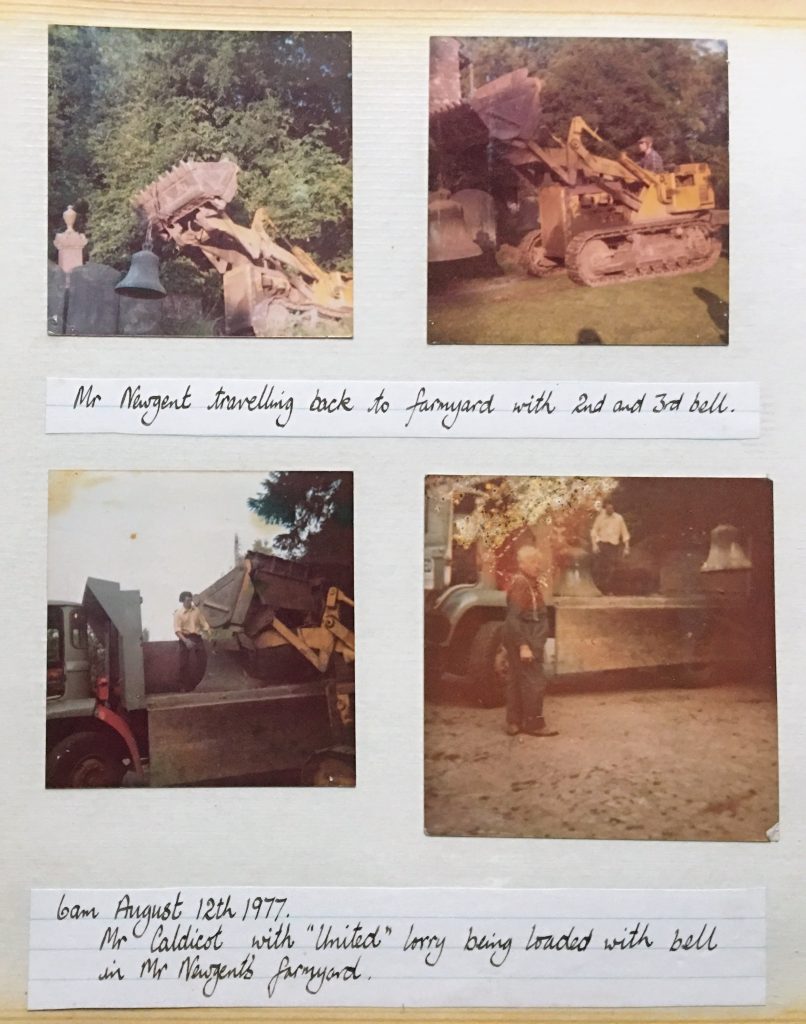
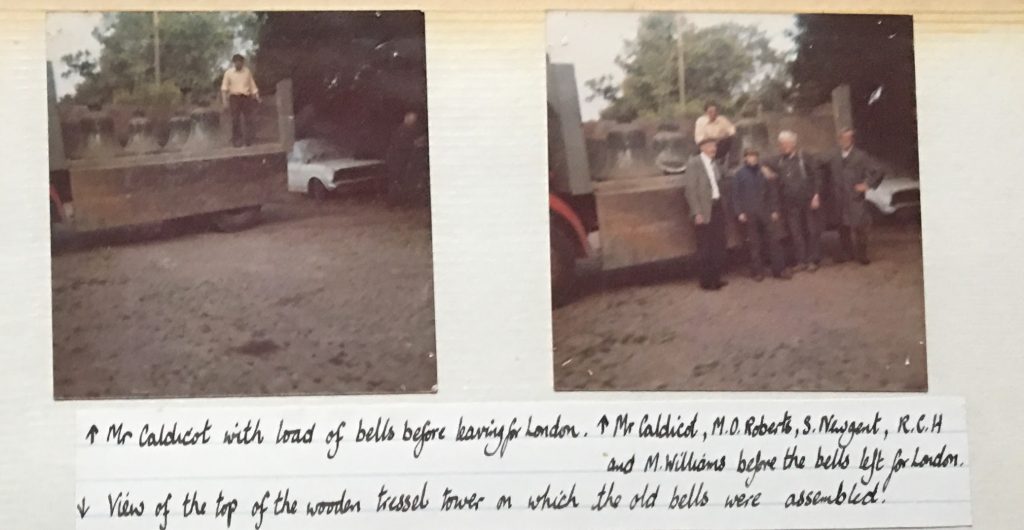
The story behind the installation of the new bells
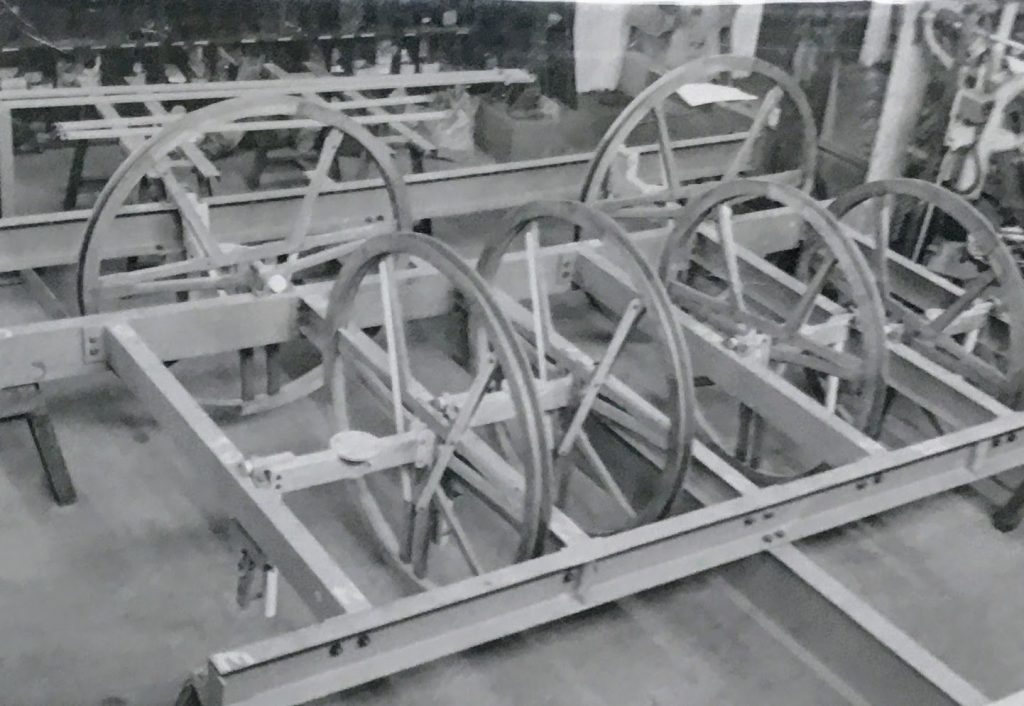
The images show a new metal frame
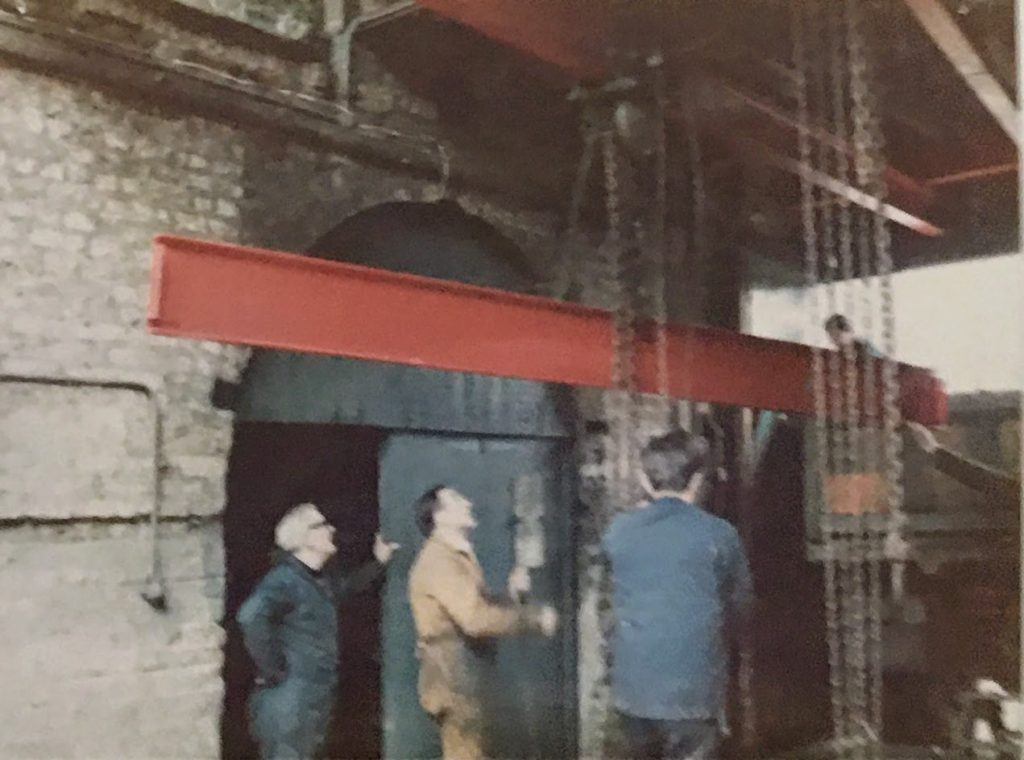
Loading of a girder at the Whitechapel Bell Foundry on February 25, 1978.
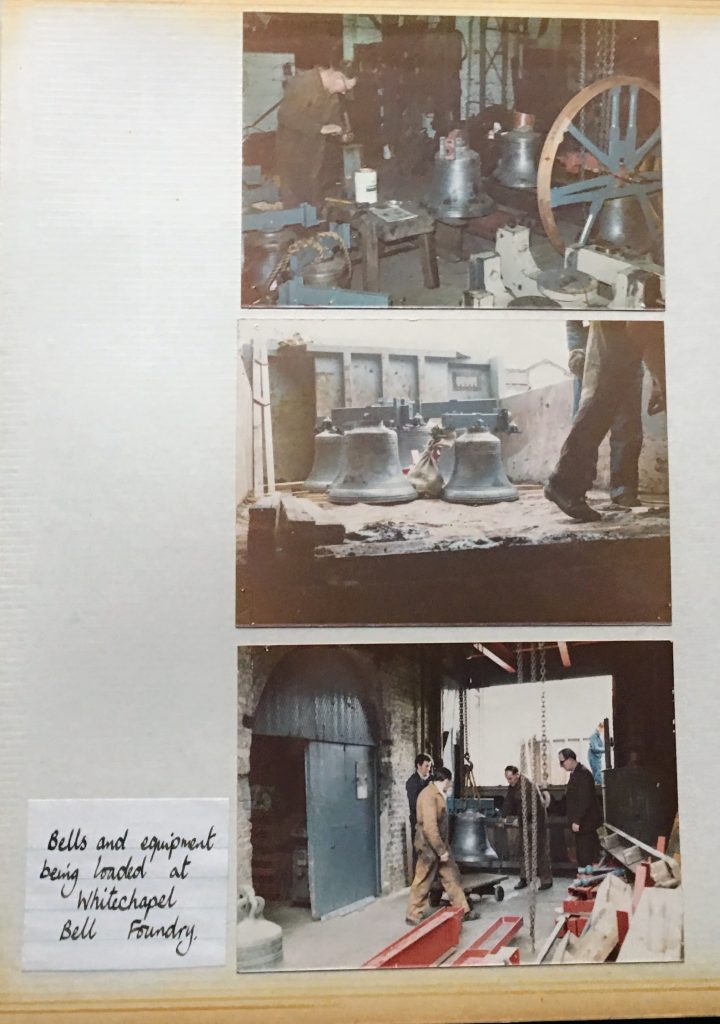
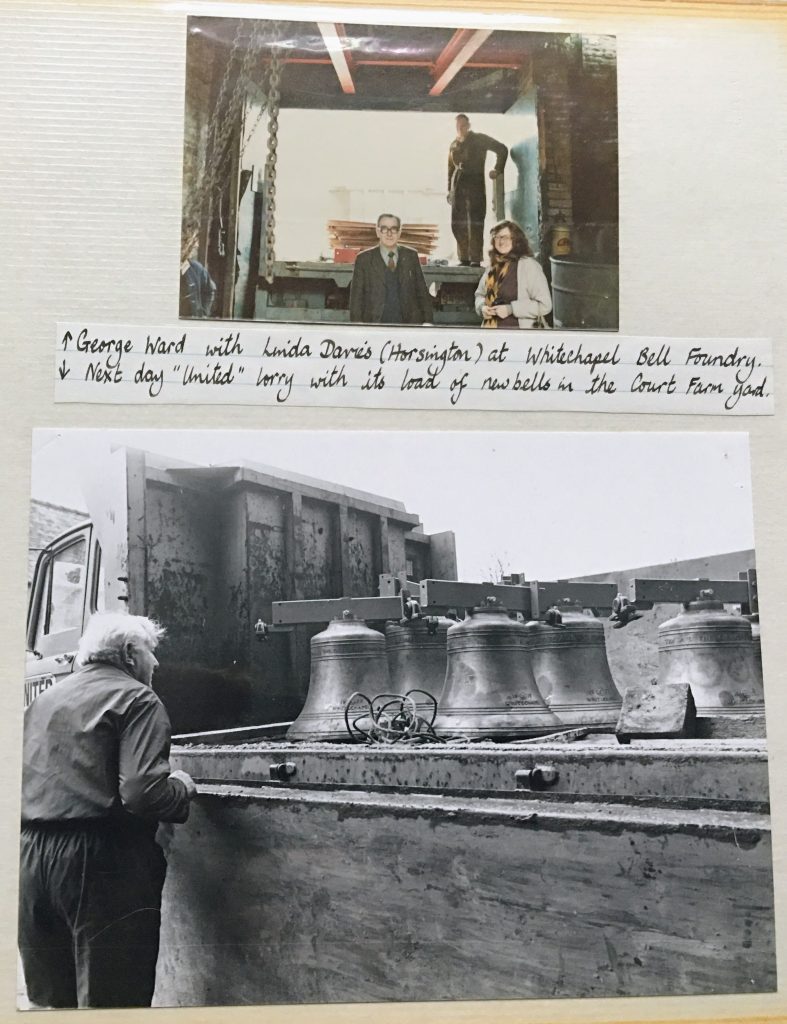
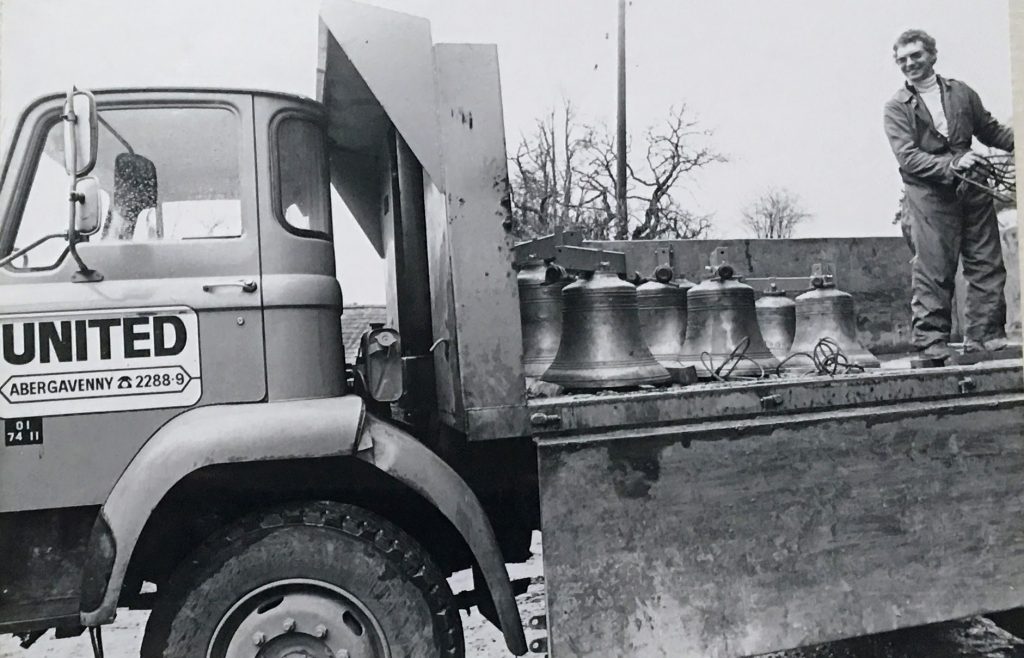
Bobby Caldicot with “United” lorry graciously provided by Mr Alan Griffiths.
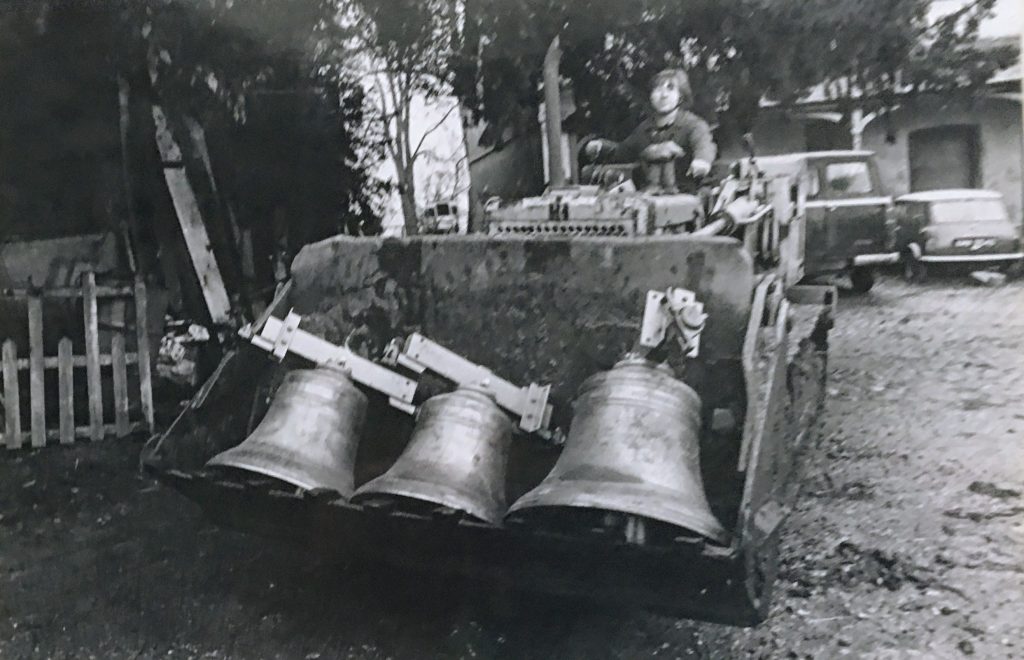
The image is a black and white photograph from February 26, 1978, showing Steven Newgent with three new bells in the bucket of a tractor, ready to enter a churchyard.
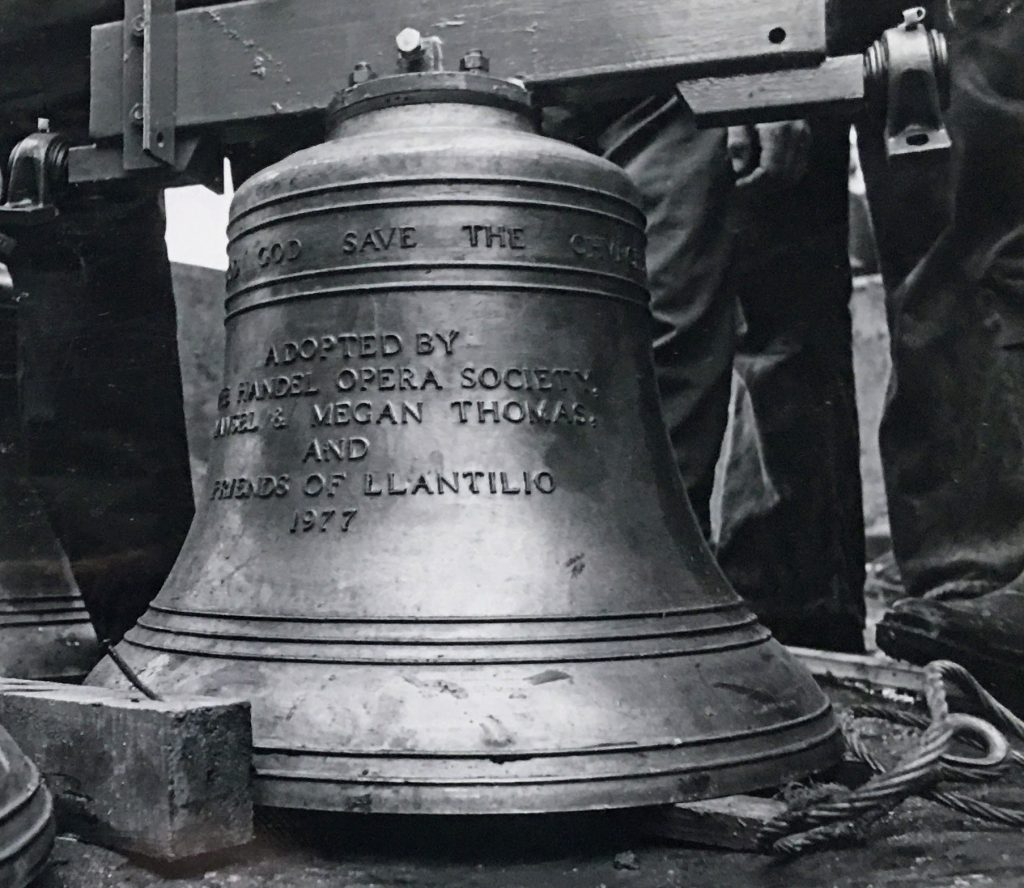
GOD SAVE THE QUEEN
ADOPTED BY HANDEL OPERA SOCIETY MEGAN THOMAS AND FRIENDS OF LLANTILIO 1977
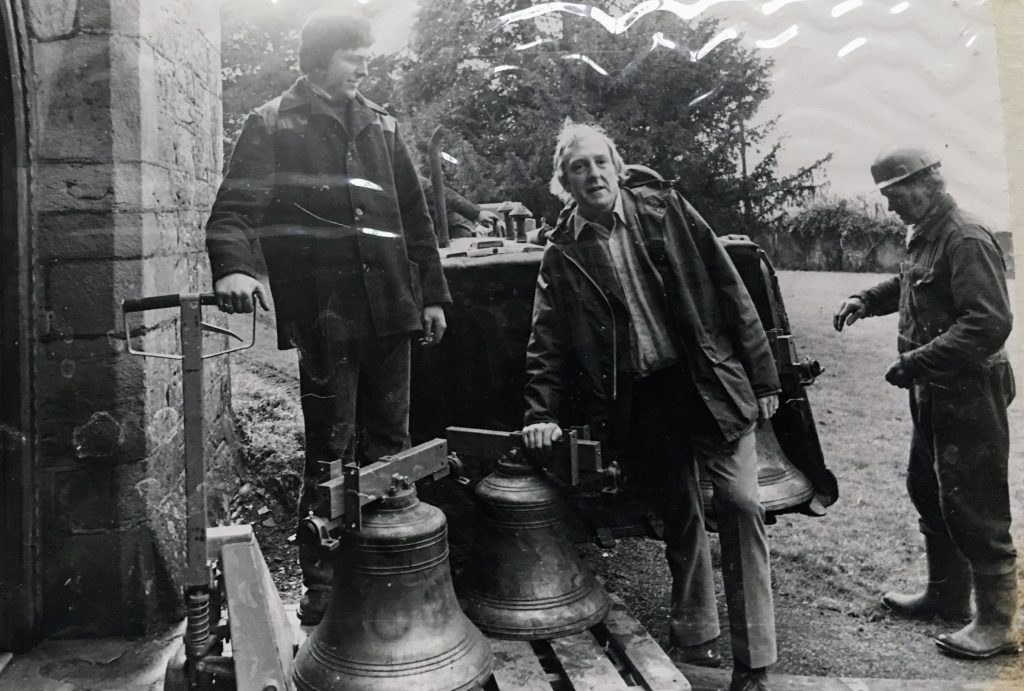
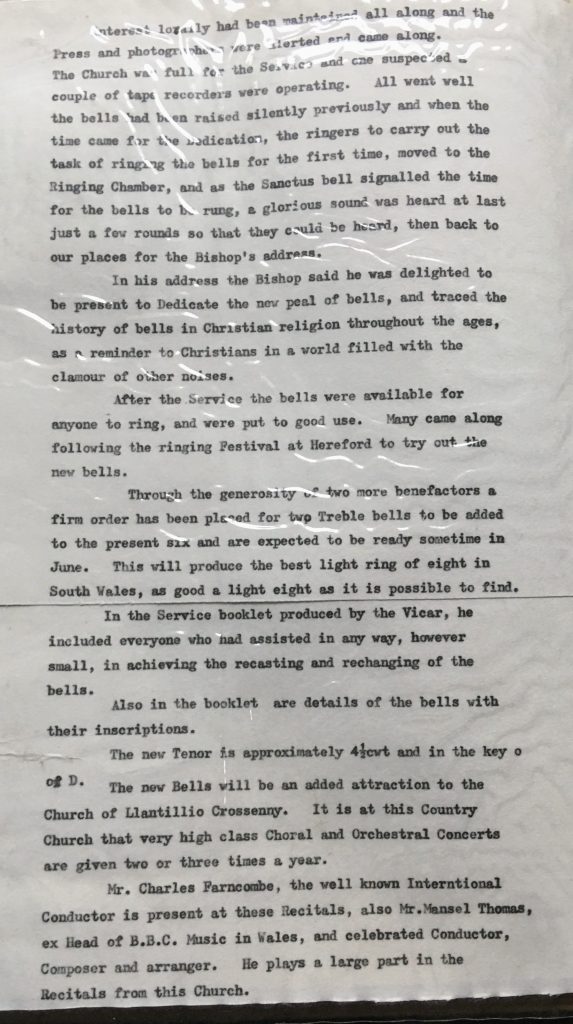
The text describes an event at the Church of Llantillio Crossenny, where a new peal of bells was dedicated. The Bishop was present to dedicate the bells and spoke about their history in Christianity. Following the service, people were able to ring the new bells. The text also mentions that two new treble bells were ordered and are expected to be ready soon, which will create a “light ring of eight” in South Wales.
The church hosts high-class choral and orchestral concerts two or three times a year, with notable conductors like Charles Farncombe and Mansel Thomas participating.
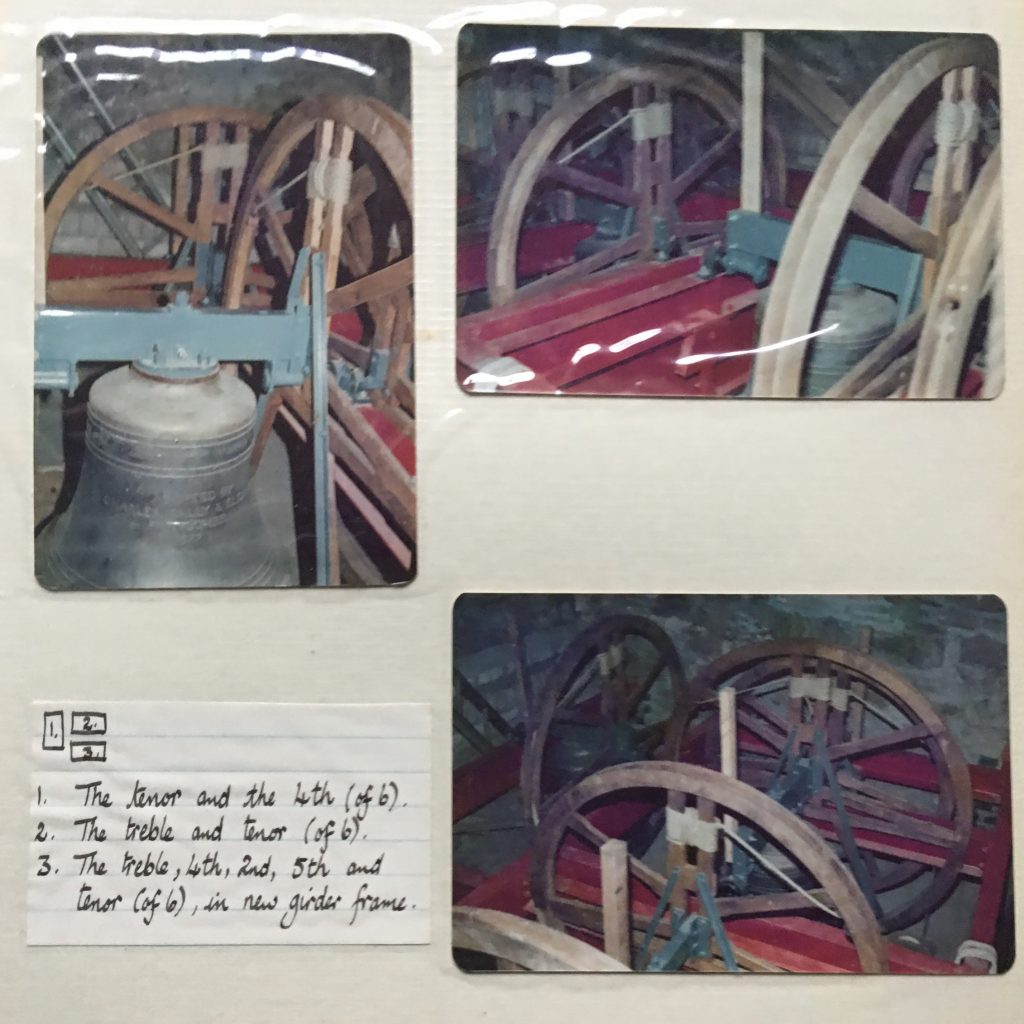
1 The tenor and the 4th of 6 bells.
2 The treble and tenor of 6 bells.
3 The treble, 4th, 2nd, 5th and tenor of 6 bells, in a new girder frame.
The terms “tenor” and “treble” refer to the largest and smallest bells in a set, respectively. The numbers refer to the position of the bells in the sequence from smallest to largest. The bells are typically hung in a frame, which can be made of wood or metal.
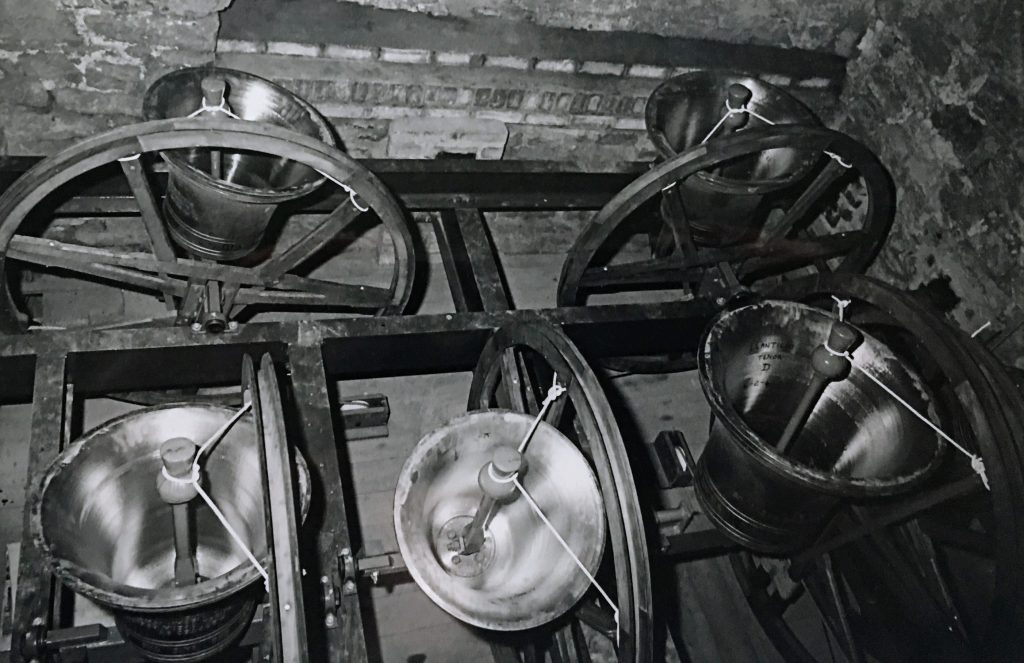
This image shows a set of church bells with their “tongues” (clappers) tied, a practice that is noted in the handwritten text on the image as occurring the day before their dedication on April 1, 1978.
Church bells are typically made from a bronze alloy of copper and tin.
The primary purpose of church bells is to call people to worship, mark special occasions, and commemorate events.
The practice of “change ringing,” where bells are rung in continuously changing patterns, originated in the 16th century when bells began to be hung with a full wheel, giving ringers control over their bell.
The sound of a bell is produced when the clapper strikes the inside, creating a dominant note and a series of complex vibrations known as “partials”.
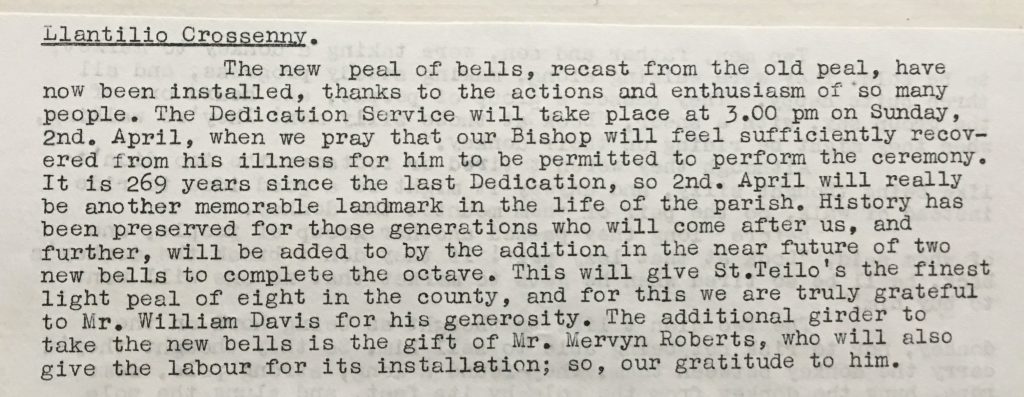
This document is a notice from Llantilio Crossenny parish about the installation of a new peal of bells at St. Teilo’s church. It announces a dedication service and thanks two individuals for their contributions.
The new peal of bells, recast from an old set, has been installed at St. Teilo’s church in Llantilio Crossenny.
A dedication service will be held at 3:00 PM on Sunday, April 2nd.
This dedication is particularly significant as it is 269 years since the last one.
Mr. William Davis is thanked for his generosity, and Mr. Mervyn Roberts is thanked for donating a girder and his labor for the installation.
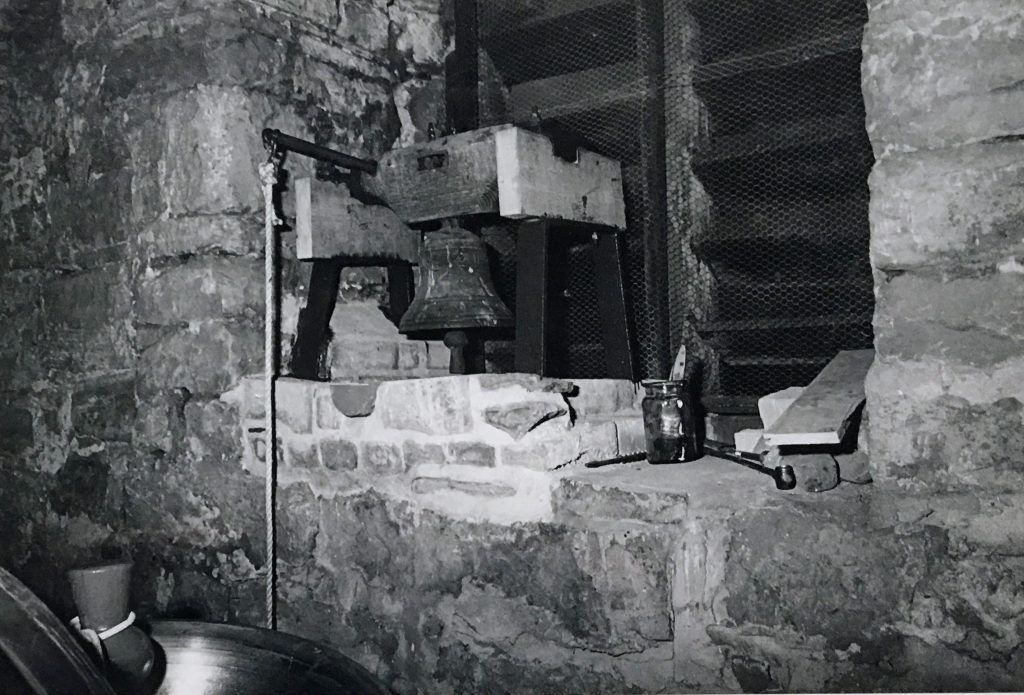
The sanctus bell which was removed from its wooden bearings and refixed on iron brackets in the same position in the north louvered window. Refixed on 21st March 1978.
The image shows a sanctus bell that was removed and then refixed with iron brackets. The text provides a brief description of the event, including the date.
Object: A sanctus bell.
Action: It was removed from its wooden bearings and refixed with iron brackets.
Location: In the same position in the north louvered window.
Date: Refixed on 21st March 1978.
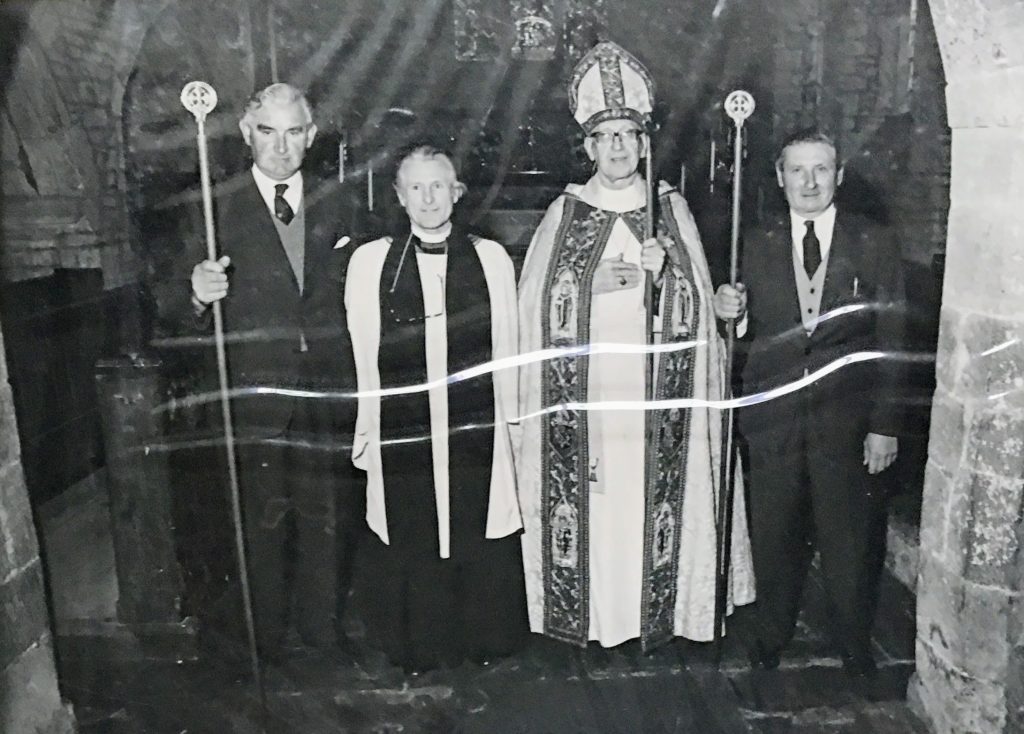
Sunday April 2nd 1978
Tom Nichols, vicar’s warden, Rev. J. Selby, The Very Reverend Derek Childs, Bishop of Monmouth and D.J. Davies, Church warden at the dedication of the six bells after receiving them from Mr. W. Hughes of Whitechapel.
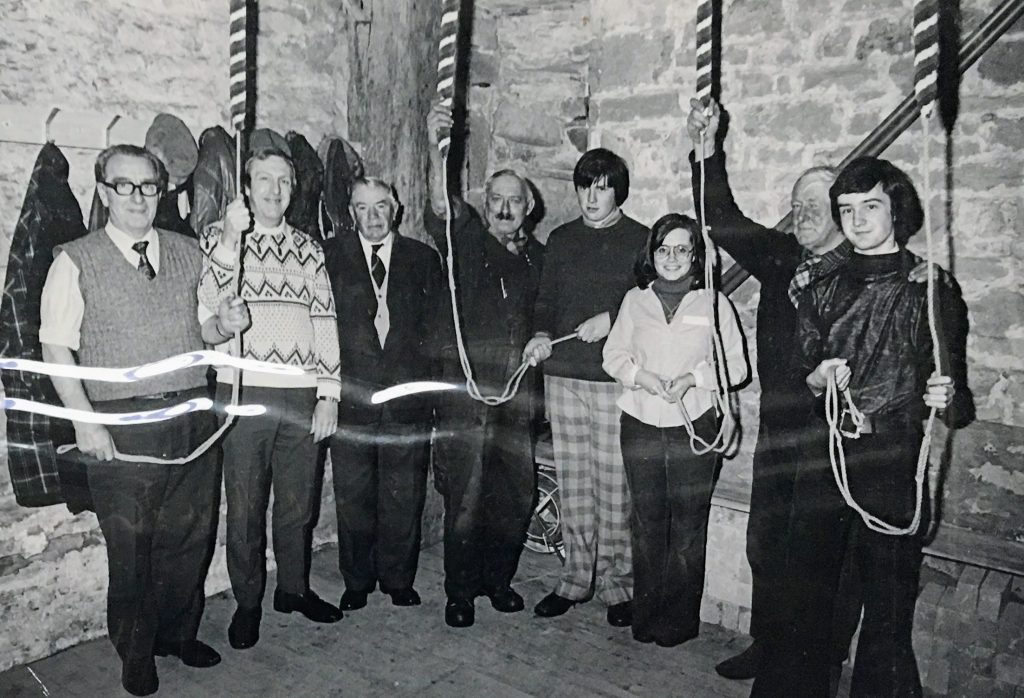
April 2nd 1978
St. Mary’s bellringers, Abergavenny on the first ring at the dedication of the bells.
G. K. Sreds, S. Clark, Ward, N. Ward, G. Lewis (retired), M.O. Roberts, K. Sneu R.C. Horsington, M. Stradling.
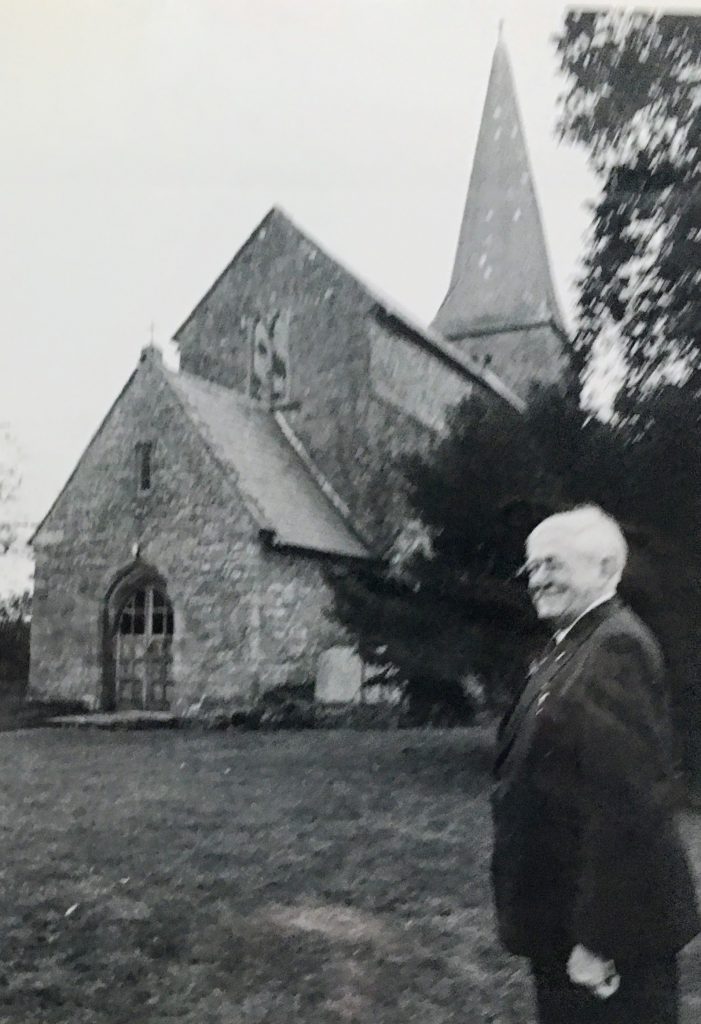
Richard Coles Horsington showing the satisfaction of doing the job
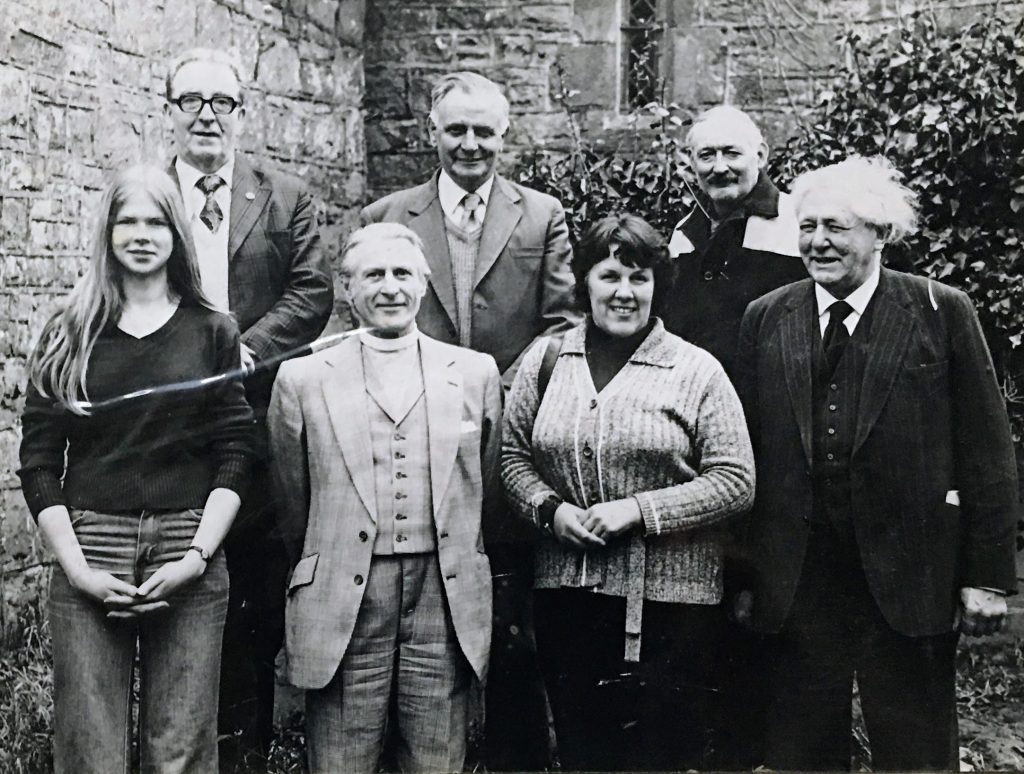
5th May the band of ringers after ringing the first quarter peal for the Llantilio Festival.. Grandsire Doubles.
Back Row: G. Ward (4), Mr Thomas (treble) , M.O. Roberts (tenor)
Front Row: Anne. D. Turner (2), Rer J. Selby, Sheila Parry (3), R.C. Horsington (5)
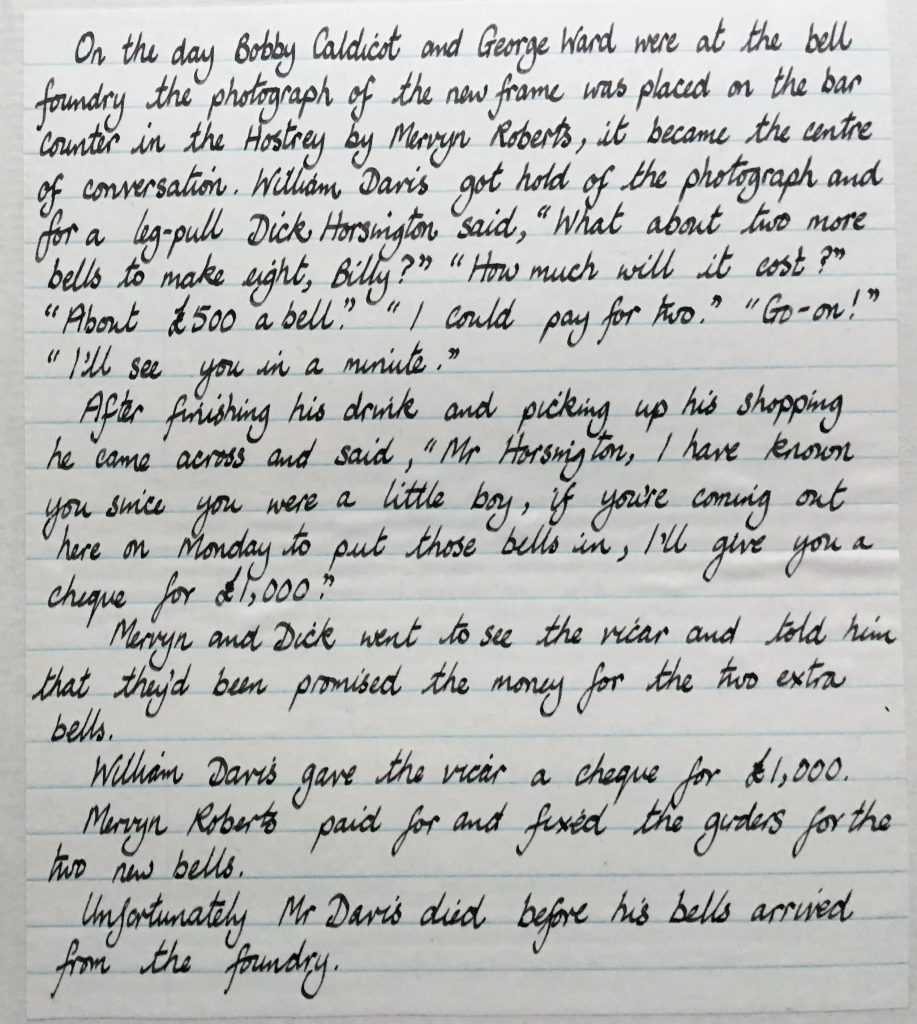
The text above is a handwritten story about two men, Bobby Caldicot and George Ward, who are at a bell foundry. A photograph of a new frame for bells becomes a topic of conversation. A man named Dick Horsington jokes about adding two more bells to make a total of eight, and another man, William Davis, offers to pay for them.
William Davis promises to pay £1,000 for two extra bells.
The money is given to the vicar via a cheque.
Mervyn Roberts is responsible for paying for and fixing the girders for the new bells.
Unfortunately, William Davis dies before the bells arrive.
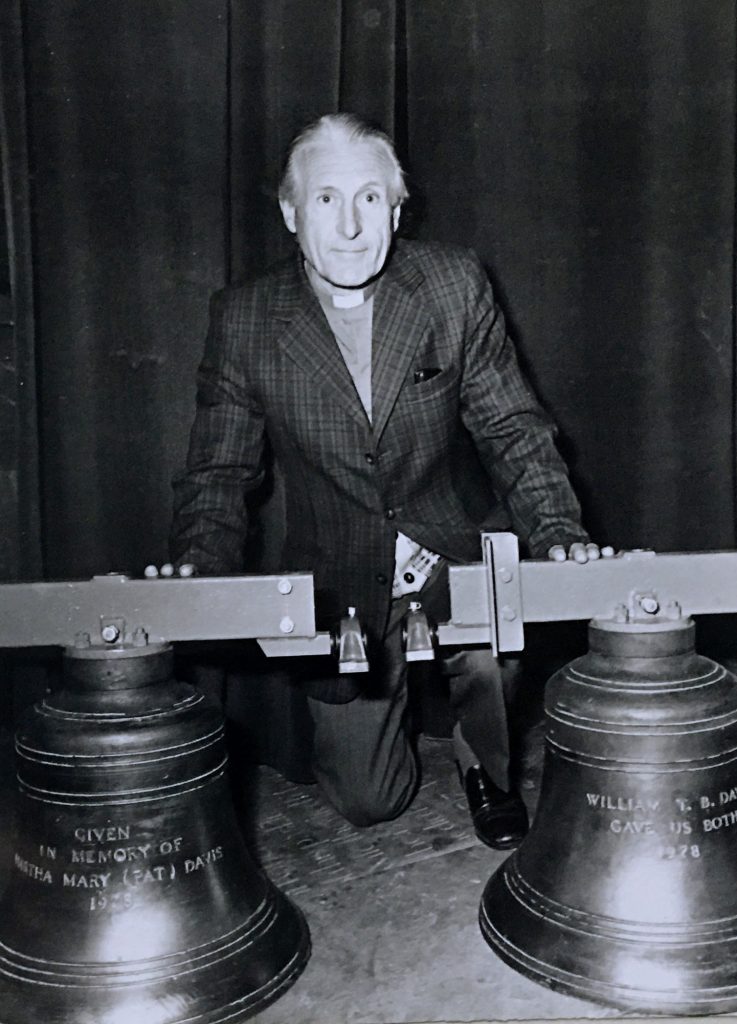
The image shows the Reverend J. Selby with new treble and second bells on September 30, 1978.
The inscriptions on the bells suggest they are dedicated in memory of individuals,
GIVEN IN MEMORY OF Martha MARY (PAT) DAVIS
1978
WILLIAM T B Davis
Gave Us BOTH 1978
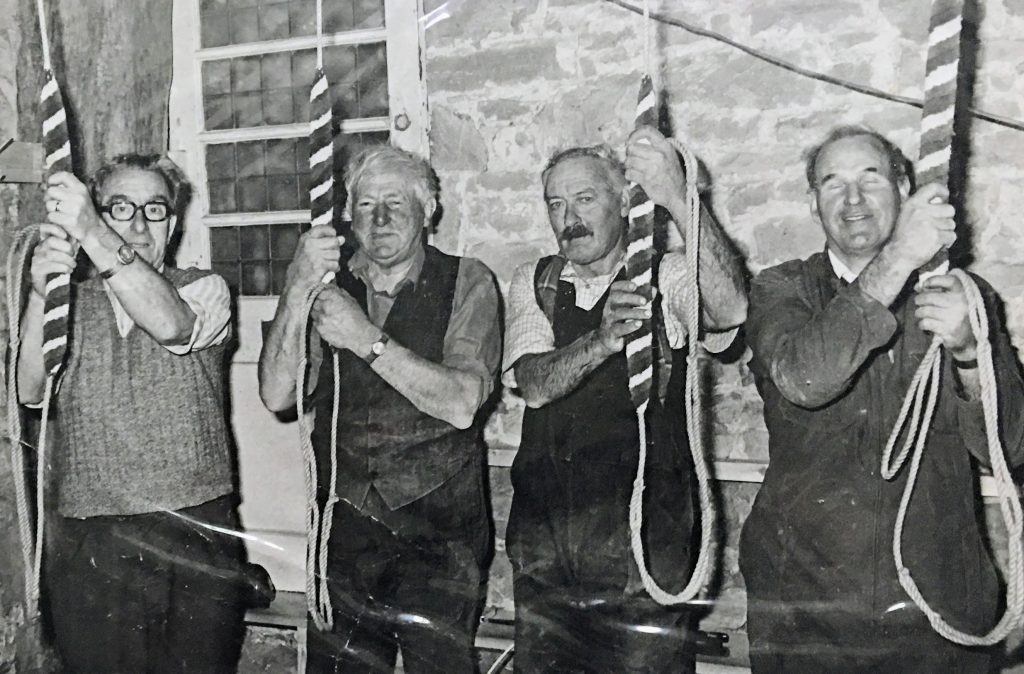
6th October 1978
George Ward, Richard C. Horsington, Mervyn O. Roberts and Philip Jakeman (from the bell foundry on completing the installation of the eight.
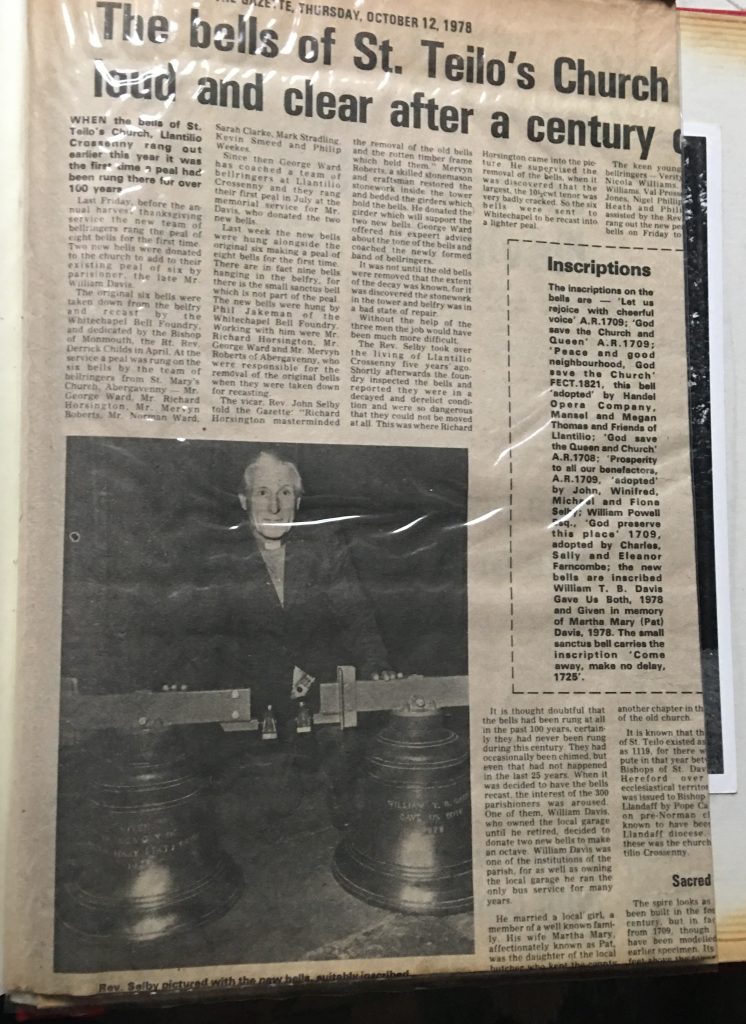
This is a newspaper article from Thursday, October 12, 1978, about the bells of St. Teilo’s Church in Llantilio Crossenny being rung for the first time in over 100 years. The article details the restoration of the bells, including the inscriptions on them and the people involved in the project.
The bells of St. Teilo’s Church in Llantilio Crossenny were rung for the first time in over a century in 1978.
The article, from October 12, 1978, discusses the restoration of the bells.
New bells were donated by William T. B. Davis in 1978, in memory of his wife, Martha Mary (Pat) Davis.
The article includes a list of the inscriptions found on the bells.
Inscriptions
The inscriptions on the bells are Lat us rejoice with cheerful voice A.R.1700: ‘God save the Church and Queen A.8.1700, “Peace and good neighbourhood, Ged save the Church P
FECT.1821, this bell adopted by Handel Opera Company. Mansel and Megan Thomas and Friends of Llantilio:
‘God save the Queen and Church A.R.1700: Prosperity to all our benefactora, A.R.1700. adopted by John, Winifred. Michal and Fiona Se William Powell God preserve this place 1709, adopted by Charles, Sally and Eleanor Ferncombe; the new balls are inscribed William T. B. Davis Gave Us Both, 1578 and Given in memory of Martha Mary (Pat) Davis, 1978. The small sanctus bell carries the Inscription ‘Came away, make no delay. 1725
